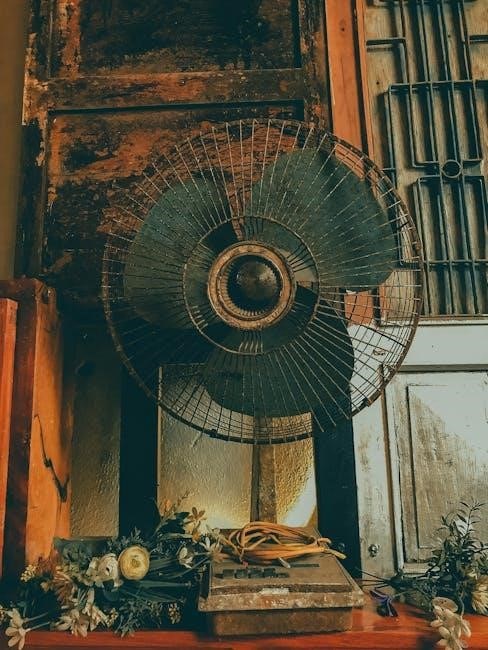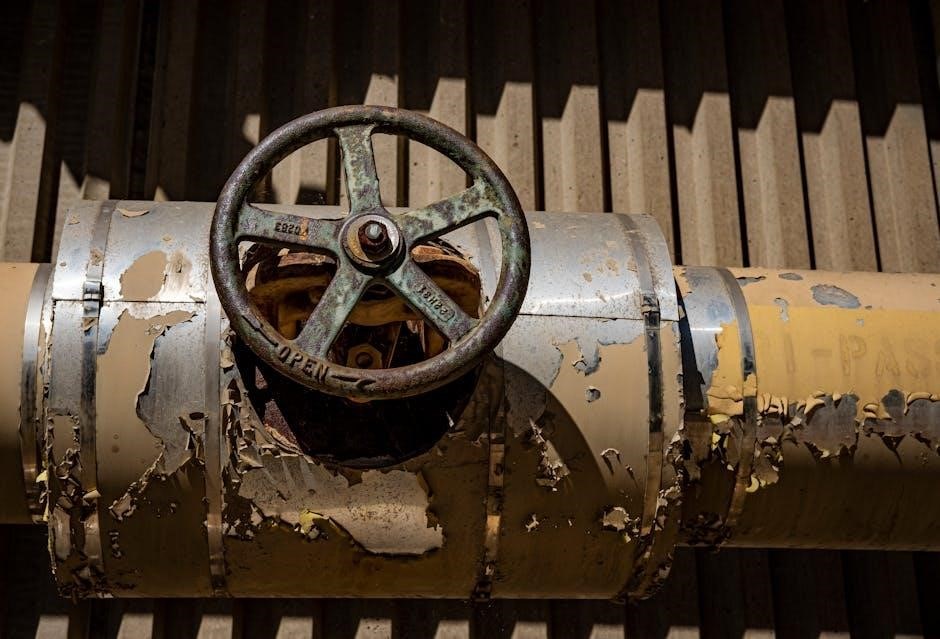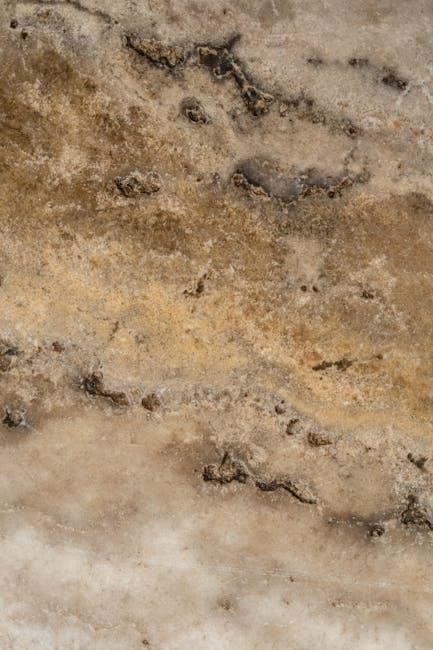Valve guides are critical engine components that direct valves and maintain proper seating. Made from durable materials like bronze or steel, they ensure efficient combustion and engine performance. Worn guides can lead to oil seepage, reduced efficiency, and increased emissions, necessitating timely inspection and maintenance to prevent severe engine damage.
1.1 Definition and Function of Valve Guides
Valve guides are cylindrical components in an engine’s cylinder head that direct the movement of valves, ensuring proper alignment and seating. They are typically made of durable materials like bronze or steel to withstand high temperatures and mechanical stress. Their primary function is to guide the valve stem, absorb side forces, and maintain a tight seal to prevent oil leakage and ensure efficient combustion.
1.2 Importance of Valve Guides in Engine Performance
Valve guides play a crucial role in maintaining optimal engine performance by ensuring precise valve operation. They prevent oil leakage into combustion chambers, reducing emissions and improving fuel efficiency. Properly functioning guides also maintain the integrity of the combustion process, preventing performance issues like power loss or rough engine operation. Neglecting worn guides can lead to severe engine damage and decreased overall efficiency.

Causes of Worn Valve Guides
Worn valve guides result from mechanical wear, thermal stress, and insufficient lubrication. Over time, these factors degrade the guides, compromising engine efficiency and performance.
2.1 Mechanical Factors
Mechanical wear from repetitive valve movement is a primary cause of worn guides. Misaligned valves and improper seating exacerbate wear, while worn valve train components like lifters or rocker arms can also contribute. Over time, these mechanical stresses degrade the guides, leading to increased clearance and reduced engine efficiency. High-mileage engines are particularly susceptible to such wear due to prolonged operational stress.
2.2 Thermal Factors
Thermal stress from high engine temperatures can cause valve guides to warp or crack. Prolonged exposure to heat leads to material degradation, reducing their durability. Additionally, improper cooling or imbalanced combustion can exacerbate guide wear, affecting engine performance over time.
2.3 Improper Maintenance
Neglecting regular engine upkeep, such as infrequent oil changes, can accelerate valve guide wear. Lack of lubrication and failure to address issues like valve stem seals contribute to premature degradation. Additionally, improper installation or poor fitting during repairs can stress the guides, leading to rapid wear and associated engine performance issues over time.

Symptoms of Worn Valve Guides
Worn valve guides often manifest through visible smoke, increased oil consumption, and reduced engine efficiency. These symptoms typically worsen during engine startup and idle conditions.
3.1 Visible Signs of Wear
Visible signs of worn valve guides include excessive oil residue around valve train components, worn or loose guide bushings, and physical damage to guide surfaces. These signs often correlate with performance issues and require immediate attention to prevent further engine degradation and potential component failure.
3.2 Performance Issues
Worn valve guides often lead to reduced engine performance, including decreased power output and efficiency. Oil seepage into cylinders can cause white smoke from the exhaust, especially during startup. Improper valve seating and movement may result in poor compression, leading to rough engine operation and reduced fuel efficiency. Addressing these issues early is crucial to prevent further damage and maintain optimal engine functionality.

3.4 Diagnostic Indicators
Common diagnostic indicators of worn valve guides include excessive oil consumption and visible smoke from the exhaust, particularly white smoke during startup. Compression tests may reveal lower-than-normal readings, and leak-down tests can identify air escaping through the guides. These signs, combined with a thorough visual inspection, help confirm the presence of worn valve guides, enabling timely and effective repairs to prevent further engine damage.

Diagnosis of Worn Valve Guides
Diagnosing worn valve guides involves visual inspections for wear, compression tests to identify low readings, and leak-down tests to detect air escaping through the guides. These methods help confirm wear and guide necessary repairs.
4.1 Visual Inspection
A visual inspection is a fundamental step in diagnosing worn valve guides. Technicians examine the valve guide area for signs of excessive oil or residue, which may indicate seepage. They check the valve stem for abnormal movement and inspect the guide’s surface for wear patterns or discoloration. Tools like bore gauges may be used to measure wear and assess the guide’s fit with the valve stem.
4.2 Compression Test
A compression test is a reliable method to identify worn valve guides. By measuring cylinder pressure, technicians can detect internal engine issues. Low compression readings may indicate valve guide wear, allowing oil to seep into combustion chambers. This test helps confirm suspicions of guide wear, especially when combined with visible symptoms like white exhaust smoke, which results from burning oil in the cylinders.
4.3 Leak-Down Test
A leak-down test is a precise diagnostic tool for identifying worn valve guides. By pressurizing a cylinder and monitoring pressure retention, technicians can locate leaks. Escaping air indicates worn guides or damaged seats. This test provides detailed insights into the severity of wear, helping pinpoint exact issues without disassembling the engine, ensuring accurate repairs and maintaining engine integrity.

Effects of Worn Valve Guides
Worn valve guides lead to reduced engine performance, increased oil consumption, and higher emissions. They compromise combustion efficiency and can cause long-term engine damage if left unaddressed.
5.1 Reduced Engine Performance
Worn valve guides can lead to reduced engine performance by allowing excessive oil consumption and combustion gases to escape. This results in decreased power output, poor fuel efficiency, and rough engine operation. Over time, the engine may struggle to maintain optimal performance, leading to sluggish acceleration and potential stalling, especially under load or during acceleration.
5.2 Increased Oil Consumption
Worn valve guides allow engine oil to seep into the cylinders, leading to increased oil consumption. This results in higher maintenance costs and frequent oil top-ups. The oil, when burned during combustion, produces white smoke from the exhaust, especially noticeable during engine startup. Regular inspection and timely replacement of valve guides are essential to prevent excessive oil usage and related engine damage.
5.3 Emissions and Environmental Impact
Worn valve guides contribute to increased emissions by allowing oil to burn during combustion, releasing pollutants like particulate matter and carbon monoxide. This leads to higher emissions levels, potentially failing environmental standards. The environmental impact includes air quality degradation and contributions to global warming. Addressing worn valve guides is crucial for reducing a vehicle’s ecological footprint and ensuring compliance with emissions regulations.

Prevention of Valve Guide Wear
Preventing valve guide wear involves regular maintenance, proper lubrication, and using high-quality materials to ensure durability and optimal engine performance over time.
6.1 Regular Maintenance
Regular maintenance is essential to prevent valve guide wear. This includes frequent oil changes to reduce contamination, cleaning the valve train, and inspecting for wear. Lubrication ensures smooth operation, while replacing worn parts early prevents further damage. Proper maintenance schedules and inspections can extend the life of valve guides, maintaining engine efficiency and performance. Regular checks help identify issues before they escalate.
6.2 Proper Lubrication
Proper lubrication is vital for minimizing valve guide wear. Using high-quality engine oil ensures reduced friction and heat, which can degrade valve guides over time. Regular oil changes and the use of appropriate viscosity grades help maintain optimal lubrication. Additionally, ensuring clean oil flow prevents contaminants from accelerating wear. Consistent lubrication practices are crucial for extending the lifespan and functionality of valve guides in engine operations.
6.3 Material Selection
Selecting the right materials for valve guides is crucial for durability and performance. Bronze and steel are common choices due to their strength and heat resistance. Modern alloys may offer improved wear resistance. Proper material selection ensures reduced wear, better heat dissipation, and optimal lubrication. High-quality materials help extend valve guide lifespan, maintaining engine efficiency and reducing maintenance needs over time.

Repair and Replacement
Repair or replacement of worn valve guides involves removing the old guides, installing new ones, and ensuring proper alignment. This restores engine efficiency and prevents further damage.
7.1 Inspection and Assessment
Inspection involves visually examining valve guides for wear, measuring clearances, and checking for oil seepage. Assessment determines the extent of damage, guiding whether repair or replacement is needed. Proper tools and expertise ensure accurate evaluation, preventing further engine issues and ensuring optimal performance post-repair. This step is crucial for effective maintenance and longevity of the engine.
7.2 Replacement Process
The replacement process involves removing the old valve guides using specialized tools, ensuring minimal damage to surrounding components. New guides are then press-fit or threaded into place, depending on the engine design. Proper alignment and lubrication are critical to ensure smooth operation. Following manufacturer guidelines and using the correct tools helps achieve a precise fit, restoring engine performance and preventing future wear.
7.3 Post-Repair Testing
Post-repair testing ensures the valve guides are functioning correctly. A compression test checks for leaks, while a leak-down test verifies valve seating integrity. Monitoring engine performance, oil consumption, and exhaust smoke helps confirm the repair’s success. Proper testing guarantees reliable operation, prevents future issues, and ensures optimal engine performance and efficiency.

Cost Implications
Repairing worn valve guides involves labor costs for skilled mechanics, replacement parts, and potential additional fixes, making it a significant expense that escalates if neglected.
8.1 Labor Costs
Labor costs for repairing worn valve guides are significant due to the specialized skills and time required. Mechanics must disassemble the engine, inspect, and replace guides, often using specialized tools. The expertise needed drives up labor expenses, typically ranging from $500 to $1,500 depending on the complexity and shop rates. These costs highlight the importance of preventive maintenance to avoid extensive repairs.
8.2 Parts and Materials
Replacing worn valve guides requires high-quality materials like durable bronze or steel alloys to ensure longevity. The cost of replacement parts varies, typically ranging from $50 to $200 per guide, depending on the engine type and brand. Additional materials, such as lubricants and seals, may add to the expense. Using OEM or equivalent parts is crucial to maintain engine performance and prevent future wear.
8.3 Potential Additional Repairs
Addressing worn valve guides often reveals related issues, such as damaged valve seats or stem seals. Additional repairs may include resurfacing the cylinder head, replacing piston rings, or fixing the PCV system. In severe cases, valve seat replacement or head machining might be necessary, increasing costs. These repairs ensure proper engine functionality and prevent further damage, highlighting the importance of comprehensive inspection during guide replacement.
Case Studies
Real-world examples, such as high-mileage vehicles and neglected maintenance scenarios, illustrate the consequences of worn valve guides, offering practical insights into diagnosis, repair, and prevention strategies.
9.1 High-Mileage Vehicle
A high-mileage vehicle, such as a truck with over 200,000 miles, often experiences worn valve guides due to prolonged engine operation. Symptoms like white smoke from the exhaust and increased oil consumption are common. Diagnosis typically involves leak-down tests and visual inspections. If neglected, this can lead to severe engine damage, emphasizing the importance of regular maintenance to prevent such issues in high-mileage vehicles.
9.2 Neglected Maintenance
Neglected maintenance is a common cause of worn valve guides. Over time, lack of lubrication and inspections leads to excessive wear, causing oil seepage and performance issues. Vehicles with ignored maintenance schedules often show visible signs like white smoke from the exhaust and increased oil consumption. Addressing these issues early is crucial to prevent further engine damage and costly repairs down the line.

Tools and Materials
Specialized tools like valve guide installers and pullers are essential for precise repairs. High-quality materials, such as durable bronze or steel guides, ensure longevity and optimal engine performance.
10.1 Specialized Tools
Valve guide repair requires specialized tools, such as valve guide installers and pullers, to ensure precise removal and installation. These tools minimize wear and prevent further damage. A guide driver aligns the guide during installation, while a pilot ensures proper fitment. High-quality tools are essential for achieving accurate results and maintaining engine integrity. Specialized equipment helps technicians perform repairs efficiently and effectively, reducing the risk of additional damage to surrounding components.
10.2 Replacement Parts
Replacement parts for worn valve guides include high-quality bronze or steel alloy guides designed to withstand engine heat and stress. It’s crucial to select parts that match the engine’s specifications for proper fitment and performance. Incorrect or low-quality parts can lead to increased oil consumption and further engine damage. Always consult a parts catalog or a professional to ensure compatibility and reliability.
Worn valve guides significantly impact engine performance, efficiency, and longevity. Addressing the issue promptly through proper diagnosis, maintenance, and replacement is essential to prevent further damage. Regular inspections, quality replacement parts, and adherence to maintenance schedules can ensure optimal engine function. By understanding the causes, symptoms, and solutions, vehicle owners can maintain their engines effectively, avoiding costly repairs and environmental impact.
